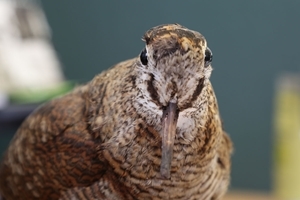By Annabel Cook, GWCT Communications & Fundraising Manager
 There’s something about woodcock that appeals to me. Also to many other people, if the public support of the Woodcock Watch project is anything to go by.
There’s something about woodcock that appeals to me. Also to many other people, if the public support of the Woodcock Watch project is anything to go by.
I hadn’t thought much about woodcock before starting work at the GWCT. But halfway through my first day I noticed a stuffed one perched on top of the cupboard behind me with a big grin on its face. At least, that’s how its feather markings seem, when viewed head on.
This peculiar little wading bird has been studied by the GWCT for 35 years, with the Woodcock Watch project launching in 2012 to examine their numbers and migrations in more depth. We have a small resident population, which stays in the UK year-round. But there is also a larger population that winters in the UK, then migrates east for the summer. 59 birds have now been satellite-tagged to explore their amazing migrations.
Looking at the data you can see that individual birds fly thousands of kilometres. The longest distance we have recorded is 7,000km (4,350 miles) to Western Siberia. Pretty impressive for a species that weighs about 300g (about three average tomatoes, if you’re wondering). Not only that, but they then return later in the year, usually to exactly the same area in the UK. Us humans can’t always manage to find our way around that well, even when armed with the latest GPS technology. Let’s add in another statistic – our data suggest that migrating woodcock fly at up to 45 mph, often for 10-12 hours at a time. That’s pretty serious flapping.
But it’s not all excitement and amazing statistics. While the European population is pretty healthy, the British breeding population has suffered serious declines over the past 40 years. It’s now on the UK Red List as a bird of conservation concern.
What can you do to help? Three things seem to be key:
- Support Woodcock Watch, as the more we can find out about the breeding behaviour and habitat requirements of our native breeding woodcock, the more we can do to help them.
- Help us monitor numbers of resident woodcock. To learn more and sign up, visit the BTO website.
- If you shoot, wait until at least November before going after woodcock and show restraint. The later in the season you shoot, the lower the chance of taking a resident bird.
Love your woodcock and have a happy World Migratory Bird Day!